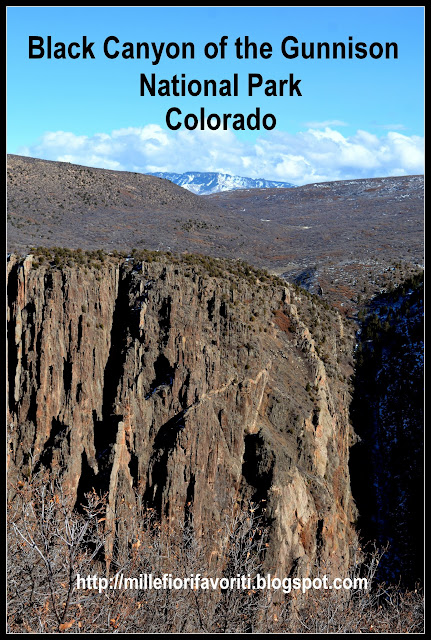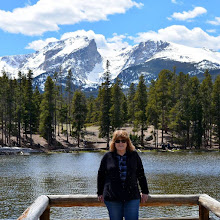Last autumn, my husband and I drove to a family wedding in the Phoenix, Arizona area. We wanted to drive, instead of fly, in order to see more of this beautiful area of country. One of the places we stopped to see on our two day drive to Arizona was Mesa Verde National Park. The park is located in southwestern Colorado, midway between the towns of Cortez and Mancos, off US 160. From the highway to the park headquarters it is 21 scenic miles -- about a 45 minute drive.
Mesa Verde means "green table" in Spanish, named after the forest that covered the mesa. The Mesa Verde National Park offers a spectacular look into the lives of the Ancestral Pueblo people who made it their home for over 700 years from AD 600 to 1300. Today the park protects nearly 5,000 known archaeological sites, including 600 cliff dwellings. These sites are some of the most notable and best preserved in the United States. (All photos will enlarge for easier viewing if clicked on)
About 15 miles from the highway is the Far View Visitor Center. The visitor and research center opened in mid December of 2012 and replaced the old facility. It houses a state of the art research center and is a storage facility for the park's archives and museum collection of over three million objects. It also features exhibits that focus on the contemporary American Indian cultures in the Four Corners area. The visitor center is also the area to pay the park entrance fee and buy tickets to enter some of the cliff houses on a ranger led tour.
After stopping at the visitors center to see the exhibits, we began our drive up to the top of the mesa, at an elevation of 7,000 to 7,500 feet.
The views along the long drive up were magnificent! The park recommends at least a 6 hour visit to see all of its features. We were arriving in late afternoon, so we knew we would have to condense our visit as much as possible to just see the park's highlights.
Once we arrived at the top of the mesa we were amazed to see the deep open canyon that cuts through the park!
The very first archaeological sight we viewed was the Cliff Palace.
The Cliff Palace contained approx 150 rooms, and 28 kivas, and had a population of around 100 people. The Kivas are round or rectangular rooms used for ceremonial purposes. The detail of the buildings was very well preserved considering their vast age
Two cowboys discovered Mesa Verde, specifically the Cliff Palace area, in 1891. You can read their story on this link. Mesas Verde was made a National Park in 1906 by President Theodore Roosevelt.
Next, we drove to the viewpoint for the "House of Many Windows." Can you see it in the wall across the canyon?
Please click on the photo above to enlarge this placard at the site that explains more about the House of Many Windows
A closer zoom to see more of the detail. Supposedly the windows were really doors, that were once covered with animals skins or a stone slab. There are eleven rooms and a kiva on a 19 foot wide ledge.
The next area we visited was a structure called the "Pit House." The Pit House was a structure partly dug into the ground, and covered by a roof of some sort. It provided shelter from the weather and was also used to store food and for cultural gatherings and celebrations.
If you click on the photo collage above you can read area placards that tell more about the Pit House structures and their uses. Most of the ancient Pueblo people lived this way on the mesa top, until they began to build the cliff dwellings the last 75-100 years of occupying Mesa Verde.Look closely, and in the middle of the rocks in photo above, you can see our next stop--a view of the Navajo Canyon Overlook. Navajo Canyon is 700 feet deep and 15 miles long. It contains 60 cliff dwellings.
Next, we visited "Sun Point View." As you can see by these photos the late afternoon sun was shining very brightly on the structures.
Close up of Sun Point View. Archaeologists theorize that the ancient peoples that built these structures did so for protection against enemies, as well as storms and other environmental hazards. One can see how secluded, and hard to reach, that they were within the canyon's walls.
Click to enlarge this photo to read about our next stop, "Oak Tree House."
Oak Tree House held about fifty rooms and six kivas. It was multi level and made the most use of its alcove space.
Another structure that was still standing on the mesa top, was the "Sun Temple." According to modern Pueblo Indians, the Sun Temple's features classify it as a ceremonial structure. Construction of this structure does not appear to be finished and it is thought that the ancient people left the area around that time. By 1285, following a period of social and environmental instability, and severe and prolonged droughts, the people began to abandon the area and moved south to locations in Arizona and New Mexico. By 1300, the Ancestral Puebloan occupation of Mesa Verde ended.
We had almost made a full loop around and we saw the sun was beginning to get low in the sky, so we hurried along to see as much as we could.
Now instead of being at a view point next to the Cliff Palace that I showed earlier, we were directly across from it.
From this perspective you can see how well protected and hidden the structures are from the top of the mesa.
A closer look at the structures.
The last area we viewed was "Spruce Tree House."
Although our visit was short, we really enjoyed our visit to Mesa Verde National Park, and we know we will return to see more of it in the future.
Our drive back down the mesa was lit by the glorious golden glow of the setting sun, and we were soon in our hotel room in Cortez, Colorado. The next day we were going to drive west to Navajo Nation where we were going to visit the Four Corners. Please come back to read my next post to see the corners where the states of Colorado, Arizona, New Mexico and Utah meet!
I'm linking this post to the following blog events:
Blue Monday
Through My Lens Monday
Life Through the Lens Monday
Good Random Fun
Nature Notes
Grand Social
Our World Tuesday
Through My Lens Monday
Life Through the Lens Monday
Good Random Fun
Nature Notes
Grand Social
Our World Tuesday
You're Gonna Love It Tuesday
Treasure Box Tuesday
Wordless Wednesday
Oh My Heartsie Girl Wordless Wednesday
Treasure Box Tuesday
Wordless Wednesday
Oh My Heartsie Girl Wordless Wednesday
Outdoor Wednesday
Warm Heart Wednesday
Share Your Cup Thursday
Friday Photo Journal
Skywatch Friday
Share It One More Time
Warm Heart Wednesday
Share Your Cup Thursday
Friday Photo Journal
Skywatch Friday
Share It One More Time
Thank you to all the blog hosts!








































































